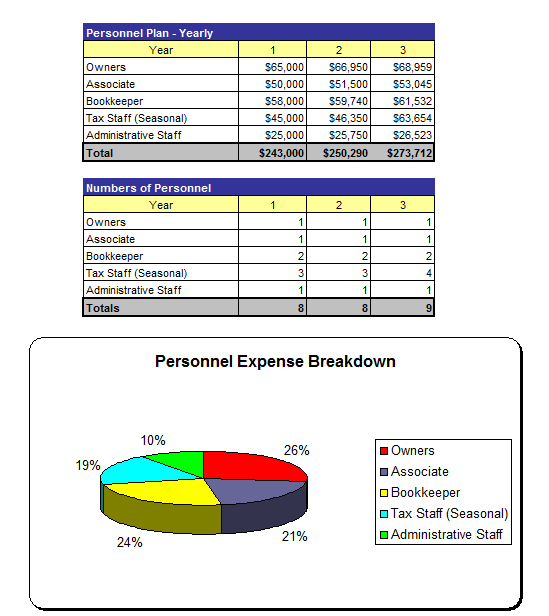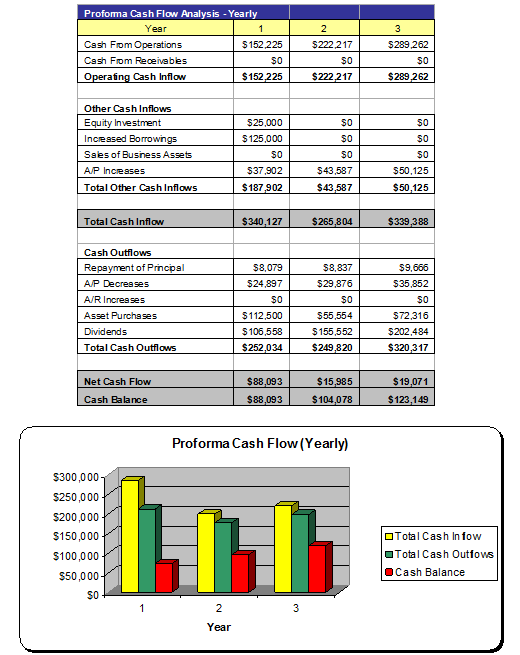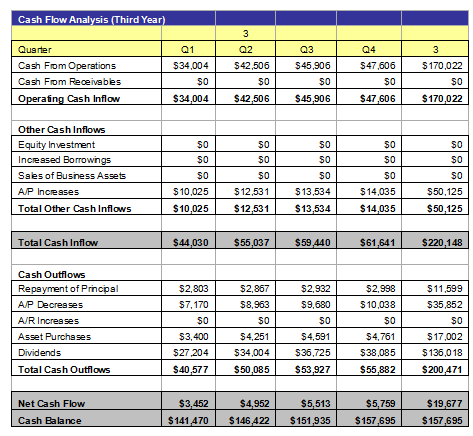Free Saw Mill Business Plan
For Raising Capital from Investors, Banks, or Grant Companies!
Please note that the financials
in this complete free business plan are completely fictitious and may not
match the text of the business plan below. This free business plan demonstration
purposes only. If you are interested in purchasing the completed editable MS Word
and Excel documents for this business plan, please click the button below! Also,
the text of the business plan is formatted with a fully automated
table of contents.
Return to
Samples Page
It should be noted that there is no special software required to use these
templates. All business plans come in Microsoft Word and Microsoft Excel format.
Each business plan features:
- Excecutive Summary
- Company and Financing Summary
- Products and Services Overview
- Strategic Analysis with current research!
- Marketing Plan
- Personnel Plan
- 3 Year Advanced Financial Plan
- Expanded Financial Plan with Monthly Financials
- Loan Amortization and ROI Tools
- FREE PowerPoint Presentation for Banks, Investors,
or Grant Companies!
1.0 Executive Summary
The purpose of this business plan is to raise $250,000 for the development of a saw milling company while showcasing the expected financials and operations over the next three years. Saw Mill, Inc. (“the Company”) is a New York based corporation that will sell large inventories lumber that are used in conjunction with manufacturing and home building. The Company was founded by John Doe.
1.1 Products and Services
As mentioned above, the business specializes in the sale of lumber to contractors, carpenters, and the general public within New York. After the launching period is complete, Mr. Doe intends to offer direct delivery services of lumber, which will significantly increase the revenues and profitability of the business while providing a value added advantage to the Company’s operations. The third section of the business plan will further describe the produces offered by the Saw Mill.
1.2 The Financing
Mr. Doe is seeking to raise $250,000 from as a bank loan. The interest rate and loan agreement are to be further discussed during negotiation. This business plan assumes that the business will receive a 10 year loan with a 9% fixed interest rate. The financing will be used for the following: • Development of the Company’s production location. • Financing for the first six months of operation. • Capital to purchase the Company’s inventory. Mr. Doe will contribute $50,000 to the venture.
1.3 Mission Statement
The Saw Mill’s mission is to become the recognized leader in its targeted market for providing lumber at a low cost.
1.4 Mangement Team
The Company was founded by John Doe. Mr. Doe has more than 10 years of experience in the lumber industry. Through his expertise, he will be able to bring the operations of the business to profitability within its first year of operations.
1.5 Sales Forecasts
Mr. Doe expects a strong rate of growth at the start of operations. Below are the expected financials over the next three years.

1.6 Expansion Plan
As time progresses, Management may seek to continually increase its manufacturing capacity by either acquiring additional production equipment or developing additional facilities while concurrently acquiring additional saw milling equipment.
2.0 Company and Financing Summary
2.1 Registered Name and Corporate Structure
Saw Mill, Inc. The Company is registered as a corporation in the State of New York.
2.2 Required Funds
At this time, the Saw Mill requires $250,000 of debt funds. Below is a breakdown of how these funds will be used:

2.3 Investor Equity
Mr. Doe is not seeking an investment from a third party at this time.
2.4 Management Equity
John Doe owns 100% of the Saw Mill, Inc.
2.5 Exit Strategy
If the business is very successful, Mr. Doe may seek to sell the business to a third party for a significant earnings multiple. Most likely, the Company will hire a qualified business broker to sell the business on behalf of the Saw Mill. Based on historical numbers, the business could fetch a sales premium of up to 4 times earnings.
3.0 Products and Services
The business, in its warehouse and milling, will maintain an extensive inventory of wood products for real estate development and carpentry purposes. The Company will provide the following types of wood to its customers: • African Mahogany • Alder • American Cherry • Ash • Black Walnut • Brazilian Cherry • Canarywood • Carribean Rosewood • Cumaru • Gonalco Alves • Honduras Mahogany • Lacewood • Maple • Padouk • Plainsawn Bubinga • Poplar • Quatersawn Bubinga • Quartersawn White Oak • Raintree • Red Oak • Santos Mahogany • Spanish Cedar • Teak • Tiete Rosewood • Wenge • White Oka • Yellowheart • Zebrawood The business will sell lumber on both a wholesale and retail basis directly to contractors and the general public. Management is currently examining the standardized cost of goods markup that Management will employ for sales to contractors and retail sales.
4.0 Strategic and Market Analysis
4.1 Economic Outlook
This section of the analysis will detail the economic climate, the saw milling industry, the customer profile, and the competition that the business will face as it progresses through its business operations. Currently, the economic market condition in the United States is moderate. The meltdown of the sub prime mortgage market coupled with increasing gas prices has led many people to believe that the US is on the cusp of a double dip economic recession. This slowdown in the economy has also greatly impacted real estate sales, which has halted to historical lows. However, Saw Mills tend to operate with great economic stability as people will continue to purchase these goods in any economic climate.
4.2 Industry Analysis
Within the United States, there are more than 3,800 companies that specialize in the production of wood products (which includes saw milling).. Aggregately, these businesses generate more than $25 billion of revenue per year while providing jobs to more than 110,000 people. Aggregate payrolls in each of the last five years have exceeded $3.5 billion. This is a mature industry, and the excepted future growth rate is expected to mirror that of the general population and economic growth. One of the strong points about this industry is that market agents operate with a strong degree of economic stability as people will continue to require lumber for a number of purposes.
4.3 Customer Profile
It is difficult to determine the average customer profile for Saw Mill, Inc. as the business will sell its lumber products directly to third party distributors and wholesalers that in turn will sell branded or bulk inventories to retail stores or directly to end users. However, based on market research, there are approximately 400 companies that specialize in the retail distribution of lumber and the Company will be able to develop a number of ongoing purchase order relationships with distributors, contractors, and specialty firms throughout the target market.
4.4 Competitive Analysis
This is one of the sections of the business plan that you must write completely on your own. The key to writing a strong competitive analysis is that you do your research on the local competition. Find out who your competitors are by searching online directories and searching in your local Yellow Pages. If there are a number of competitors in the same industry (meaning that it is not feasible to describe each one) then showcase the number of businesses that compete with you, and why your business will provide customers with service/products that are of better quality or less expensive than your competition.
5.0 Marketing Plan
The Saw Mill intends to maintain an extensive marketing campaign that will ensure maximum visibility for the business in its targeted market. Below is an overview of the marketing strategies and objectives of the Company.
5.1 Marketing Objectives
5.2 Marketing Strategies
The marketing required by the Company will be minimal as Saw Mill will not market its products directly to the general public. As stated many times in this business plan, the Company has already begun to secure purchase order relationships that will ensure that the Company can produce and immediately distribute its inventories from the onset of operations. As the business expands, the business may seek to develop relationships with additional distributors of lumber products. In these instances, Management will directly contact other distributors in the industry to discuss how the business can supply them with the raw lumber that they are seeking to distribute directly to end users and retailers. Brochures and other sales literature will be produced to showcase the facility, pricing, and operations of the business when seeking to develop new ongoing purchase order relationships.
5.3 Pricing
In this section, describe the pricing of your services and products. You should provide as much information as possible about your pricing as possible in this section. However, if you have hundreds of items, condense your product list categorically. This section of the business plan should not span more than 1 page.
6.0 Organizational Plan and Personnel Summary
6.1 Corporate Organization

6.2 Organizational Budget

6.3 Management Biographies
In this section of the business plan, you should write a two to four paragraph biography
about your work experience, your education, and your skill set. For each owner or
key employee, you should provide a brief biography in this section.
7.0 Financial Plan
7.1 Underlying Assumptions
-
• Saw Mill will have an annual revenue growth rate of 7% per year.
-
• The Owner will acquire $250,000 of debt funds to develop the business.
-
• The loan will have a 10 year term with a 9% interest rate.
7.2 Sensitivity Analysis
The Company’s revenues are modestly sensitive to changes in the general economy. The lumber products manufactured by the Company are in demand on a year round basis.
7.3 Source of Funds

7.4 General Assumptions

7.5 Profit and Loss Statements

7.6 Cash Flow Analysis

7.7 Balance Sheet
 .
.
7.8 General Assumptions

7.9 Business Ratios

Expanded Profit and Loss Statements




Expanded Cash Flow Analysis



